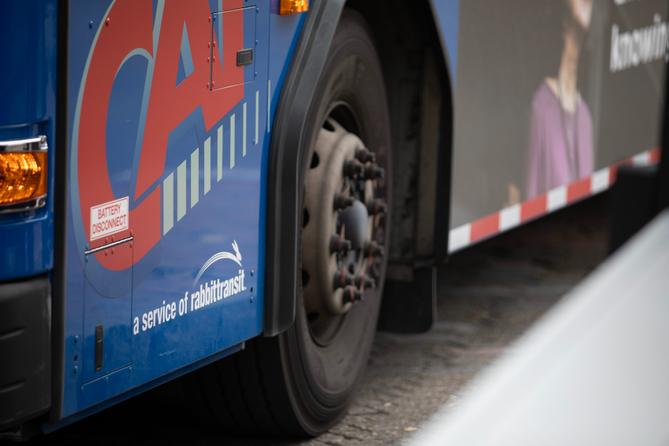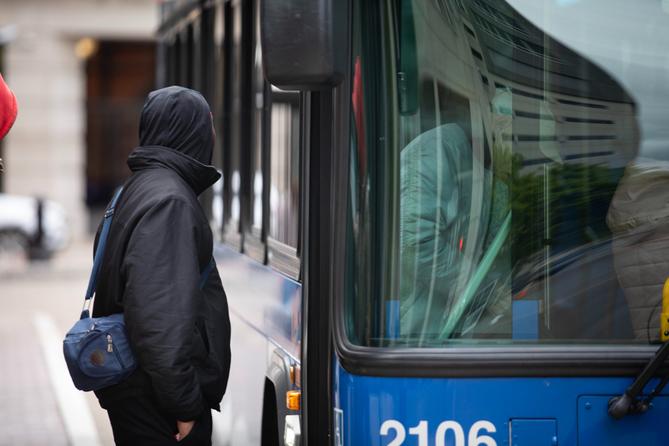Spotlight PA is an independent, nonpartisan, and nonprofit newsroom producing investigative and public-service journalism that holds power to account and drives positive change in Pennsylvania. Sign up for our free newsletters.
HARRISBURG — Dwindling federal stimulus dollars and shifting ridership have placed Pennsylvania’s dozens of transit agencies on high alert as they map out their future operations.
The end of this federal funding may force many of these systems to cut already reduced service even as ridership bounces back from its pandemic-era lows — a scenario that could feed a downward spiral in which decreased revenues necessitate more service cuts and fewer riders yield smaller revenues.
Backers of public transit, which carries hundreds of thousands of Pennsylvanians every day, want the state to send more money to these agencies. It’s a call that Gov. Josh Shapiro, a Democrat from suburban Philadelphia, plans to echo in his Feb. 6 budget address.
In a statement, Shapiro said he wants to route $1.5 billion in new state aid to public transit over the next five years.
“Investing in and improving our public transit systems is a commonsense way to create good-paying jobs, spur economic development, and help Pennsylvanians reach their destinations safely,” Shapiro said.
The proposal doesn’t suggest raising taxes. Instead, it would increase the amount of sales tax revenue transferred out of the state’s general fund, its primary bank account, to transit. This would leave fewer dollars to pay for other priorities like education and criminal justice.
Such an increase in aid would also require legislative approval from the GOP-controlled state Senate, whose leaders have so far said the proposal could be a tough sell.
State Senate Majority Leader Joe Pittman (R., Indiana) said that an expansion in state transit funding “warrants serious scrutiny” and called for a complete look at the state’s infrastructure spending.
“All areas of our state, rural, suburban and urban, must have a strong and reliable transportation network,” Pittman said in a statement.
Richard Farr — chair of the government affairs committee of the Pennsylvania Public Transportation Association, a trade organization that lobbies on behalf of agencies — told Spotlight PA that all transit systems in the commonwealth, regardless of size, will exhaust their federal stimulus dollars within the coming year and be left with hard choices.
The impending fiscal cliff isn’t just a Pennsylvania problem. Nationally, two-thirds of transit agencies predict budget deficits by 2025, according to a survey by Transportation for America, a think tank based in Washington, D.C.
But in recent weeks, both SEPTA and Pittsburgh Regional Transit, or PRT, have threatened or begun to implement service cuts.
“We are all traveling in the same stream,” Farr told Spotlight PA. “We're just in different parts of the stream going the same direction.”
“Expenses are going up, up, up”
Pennsylvania spends a lot on transit.
Last year, $1.25 billion went toward day-to-day operating expenses around the state and $650 million went toward larger, one-time capital expenses, almost exclusively to SEPTA and PRT. That’s among the highest per-capita state transit allocations in the country, according to Transportation for America.
Under Pennsylvania’s 2013 state transportation funding law, Act 89, this money is automatically routed to PennDOT from assorted state taxes and fees, and varies year to year based on how much the state brings in.
It is then distributed to Pennsylvania’s 57 transit agencies through a formula based on total passengers and vehicle miles traveled, and funds a range of services — from SEPTA’s sprawling network of bus and rail lines in Philadelphia and its suburbs, to rural van services that take older Pennsylvanians to doctors' appointments.
But that relatively robust spending doesn’t insulate the commonwealth’s transit systems from economic shifts, said Michael Danchak, director of finance, grants, and administration for the County of Lackawanna Transit System, or COLTS.
From wages to gasoline to insurance, agencies’ fixed costs have ballooned in recent years due to inflation, Danchak added.
“Expenses are going up, up, up,” he said. “So you can budget as much as you want, but if you're going to run a base level of service, you're going to have costs that increase 10%, 15%. That’s undeniable. You can’t get around that.”

Mary Buchanan, research manager at the New York City-based transit think tank TransitCenter, said protecting agencies from service cuts is critical, as most transit agencies rely on a volatile and often regressive funding structure.
This can be seen in Pennsylvania’s current transit system, in which state sales tax revenue is dispensed to agencies using a formula that includes total ridership as one of four factors that determine how much their funding increases each year.
However, both sales tax revenue and ridership can fall with even a small economic downturn. To make up for lost dollars, agencies may reduce service. But a service reduction lessens rides, further reducing fares and revenues, and allowing the cycle of cuts to repeat.
This happened during the Great Recession and the COVID-19 pandemic, Buchanan said. And absent changes, “we'll probably see this sort of situation again in the future,” she continued.
Dori Knobloch, a 49-year-old Erie resident, saw this instability firsthand. Whether she’s heading to the mall, a volunteer site, or a downtown bar to catch a concert, she relies on the Erie Metropolitan Transit Authority, or EMTA, for about three round trips a week.
That’s less than she used to. Before the pandemic, the EMTA ran all weekend. But as a cost-saving measure, the agency cut Sunday trips from its schedule. Knobloch, who uses a wheelchair, had a much quieter social calendar following the adjustment.
“It kind of gave away my freedom,” Knoblock told Spotlight PA. She couldn’t make it to church and accompanying social events until her denomination added a Saturday service two years later, she said.
The EMTA did not respond to a request for comment.
Crime concerns
Amid last fall’s budget negotiations, state House Democrats passed a funding proposal similar to Shapiro’s in an omnibus tax bill.
Pittman, state Senate Republicans’ floor leader and chief negotiator, called the proposal intriguing at the time, but it didn’t end up in the final budget deal.
Heading into this year’s budget talks, state Senate Republicans have expressed interest in tackling transportation and transit, but have tied the issue to their efforts to question the policies and authority of Philadelphia District Attorney Larry Krasner, who already was impeached in 2022 by the then-GOP-controlled state House..
After Shapiro released his funding proposal, Pittman said in a statement that “no amount of increased subsidy can restore customer confidence in making use of the network given the raging crime crisis Krasner perpetuates.”
In a statement to Spotlight PA, state Sen. Wayne Langerholc (R., Cambria), chair of his chamber’s Transportation Committee and a former district attorney, agreed that transit’s challenges include curbing crime, and did not specifically back any additional funding.
He highlighted legislation addressing that concern, pointing to a recent law creating a special prosecutor to tackle crime committed on SEPTA and a state Senate proposal to create a new felony for interfering with transit operations. Krasner is challenging the former in court; the latter passed the state Senate 47-1 and is awaiting action in a state House committee.
“Without the rule of law, our businesses, students and tourists have valid safety concerns, which continue to threaten the sustainability of public transportation,” Langerholc said.
He also highlighted a bill from state Sen. Dan Laughlin (R., Erie) that would “modernize the management of public transit agencies without increasing taxes or fees.” It is supported by the state public transit association and passed the upper chamber in December.
First-year state Sen. Nick Miller (D., Lehigh) cast the only no vote, arguing that the legislature should “go farther to invest in our public transportation infrastructure” particularly as his Lehigh Valley district “grows in overall population and job opportunities.”
Farr — who is also executive director of central Pennsylvania transit agency Rabbittransit, which serves 11 counties including those containing Harrisburg and its suburbs — added in an email that the the association supports the bill, which changes how the state distributes existing capital funding, but that it was not a substitute for efforts to increase state funding for agencies’ daily operations.
No singular option
Shapiro hasn’t suggested any changes besides boosting funding for transit by increasing the amount of state sales tax revenue transferred to the agencies.
The current funding system worries some transit advocates. Laura Weins, executive director of the grassroots group Pittsburghers for Public Transit, noted that the funding remains beholden to annual shifts in tax collection, and could easily be cut by a General Assembly with different priorities.
"The only way transit gets funded is if it's playing second fiddle — like riding on the backs of the highway lobby,” Weins told Spotlight PA. “And I think given the number of people that transit serves and the role that it plays, it seems ludicrous that that should be the mechanism.”
Creating a new, stable funding stream, she admitted, is “a $2 billion question,” but she argues the answer should include a variety of dedicated, nonregressive funding sources such as a mileage fee or a tax on rideshare companies.
“I'm not sure that there's going to be a singular option,” Weins said.
Still, Weins and other advocates said that additional funding this year would make a difference. TransitCenter’s Buchanan noted that additional money could create a positive feedback loop in which better service brings in more riders and more revenue.
In Scranton, Danchak said that COLTS is on even financial footing after using the pandemic as an opportunity to cut costs, such as reducing overtime. But looking ahead, the agency also wants to expand.
Danchak said that pushing bus service past 7 p.m., as well as adding additional buses to connect with Amtrak’s planned train from Scranton to New York City, are top priorities to meet future commuters’ needs. Adding those services, Danchak said, will require additional financial aid, like the money in Shapiro’s proposal.
“If we want to expand this service, we're going to need more help,” Danchak said.
Farr, of Rabbittransit and the Pennsylvania Public Transportation Association, declined to comment on any specific proposals, saying the details are up to the legislators.
His only suggestion was that whatever funding lawmakers agreed to should be consistent so that agencies can bank on it.
Between a competitive labor market, volatile fuel costs, and changing commuter patterns, he said, agencies need steady financial resources to fill vacancies and provide reliable service while planning for the future.
“How do you plan for tomorrow when you don't know you can even deliver today's service?” Farr said.
Policymakers may view boosting transit funding as a predominantly urban — and particularly a Philadelphia — issue, said Barry Schoch, who served as PennDOT secretary under former Republican Gov. Tom Corbett.
Schoch stumped for 2013’s Act 89, which poured billions of new dollars into transportation, including public transit, through a mix of tax, fee, and formula changes.
Schoch — now an executive with KCI Technologies, an engineering firm and frequent government contractor — said stakeholders had to balance the competing demands of transit boosters and lawmakers worried about political blowback from cost-conscious voters.
It was also a challenge, he said, to find the right mixture of funding for highways, multimodal projects, and public transportation.
“If you get too high, you can lose votes,” Schoch said. “If you get too low you could lose votes.”
Walking that tightrope, Schoch continued, requires leadership and direction. For that, he is looking to the governor’s office.
“If the transit funding is going to happen, that's up to Governor Shapiro,” Schoch said.
Shapiro will give his budget address on Feb. 6. The state Senate returns to voting session that week, and the state House returns on March 17.
BEFORE YOU GO… If you learned something from this article, pay it forward and contribute to Spotlight PA at spotlightpa.org/donate. Spotlight PA is funded by foundations and readers like you who are committed to accountability journalism that gets results.

